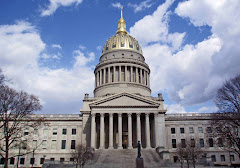Everyone thinks that the area we now know of as West Virginia just suddenly broke off from Virginia. Further, most folks believe that the whole separation movement originated in the period 1861-63 over issues surrounding Virginia leaving the Union and joining forces with other southern states in the Confederacy. Unfortunately, as with most ideas that seem to have a lot of currency in modern American thought, it is not quite as simple as all that. People who lived in the area we now know of as West Virginia had been unhappy with the way they were served by the then-government of Virginia for a long time. At least as far back as the late 1820's, possibly earlier.
In 1830, Virginia had a great Constitutional Convention. This Convention had been called by the legislature specifically to address the grievances of the "western counties." It represented a last gathering of those few Revolutionary-war era Virginians still able to get around, such as James Madison, John Marshall, and former President James Monroe. Monroe was the presiding officer.
As a result of the efforts of the "western counties," the 1830 Covention loosened the requirements for sufferage. The leadership seeing the possible change in political power that might occur, agreed to provide more services for the people west of the Alleghenies. They actually had started on this task a earlier when they sent a former engineer in the army of Napoleon Bonapart, Claudius Crozet, into the western counties to begin laying out a rudimentary system of turnpikes, and also to recommend improvements for the Kanawha and Ohio Rivers in order to improve navigation. Among other efforts, Crozet pioneered a road through western Kanawha County which he called "The Point Pleasant, Kanawha and James River Turnpike. This road still exists today and is known as State Route 622, or by the local folks as West Washington Street, up to the Cross Lanes traffic light, and Cross Lanes Drive from that point until it meets with State Rt. 25 at Rock Branch.
The government also consented to build two structures in the Western States to meet the needs of that area. The first was a hospital for the "lunatics" or "insane" or whatever politically incorrect term you wish to use. This building was built in Weston WV and was used as a hospital for the mentally unstable until about 10-15 years ago. It still stands and the folks in that area have been attempting to make it over into a "tourist attraction" (hey, it beats promoting table gaming)!

The building was erected in 1834 and served in its stated capacity until the outbreak of the Civil War. At that time, justice in the "western counties" became a very uncertain thing indeed. And, to make matters worse, several times Union Troops were sent into the Greenbrier Valley for the specific purpose of capturing the law books housed in this structure and moving them to Wheeling where the newly formed government of West Virginia could use them ("The Battle of White Sulphur Springs" is also often called "The Battle over the Law Books").
As a public building, it was occupied several times by troops from both sides who were in Lewisburg "on business." There is one place where their tell-tale graffiti has been preserved.
After the war, the Masonic Lodge of Lewisburg took over the building and used it for their meetings. The County purchased it in 1939, and converted it into a public library. When we lived in Greenbrier County, this is what it was, and all three of us (for K. was along by then), would come here to check out books when we were in town.
Just this spring, however, Greenbrier County finished a new Public Library Building just across the road and up a few hundred yards from this structure. Consequently, the structure is currently vacant. I do not know at this point what the future has in store for this building. However, I expect the folks of Lewisburg, conscious of the importance of history to the continued well-being of their town, will find an appropri ate use.
ate use.
Right beside the Law Library structure is a second structure that has been fixed up to look as if it was built at the same time for the same use. However, this is not the case. Instead it is a brick slave house from another property in Lewisburg that was moved to this spot and put to the use of the library.






















